The Virgo Asteroids and Childbirth
Gyanam and Zip Dobyns
The first American ephemeris on the asteroids was published early in 1973, giving positions of the first four asteroids to be discovered. Initial work suggested that the symbolic meaning of these small bodies was amazingly close to the mythological goddesses for whom they were named by the astronomers who discovered the new little planets. Ceres and Vesta seemed to represent the two sides of Virgo; Ceres the earth-mother concerned with work but always directed toward the well-being of human charges; Vesta the potential for such intense focus on the job that personal relationships might suffer. The job might be done at the expense of any human who was in the way, or to the exclusion of other parts of life. Of course, any factor in astrology has to be in high focus for the extremes to be manifested, and the same is true for Ceres and Vesta. High focus usually means some strong aspects to angles of the chart, or to planets. But when strong aspects existed, these tiny planets seemed really meaningful and valuable. Over the years since the first ephemeris appeared, cases have continued to support that initial impression. The cases presented here offer five women faced with pregnancy but with very different outcomes of the experience.
Case 1 wanted a baby, had a comfortable relationship with her husband, and had a normal, easy delivery with a healthy, normal baby. We can see in the mother’s chart that she identifies with the mother role with Cancer rising and places a high value on home and family with Neptune in the fourth house. Since she also has the south node of the Moon in the fourth house, we assume that there will be a lesson in integrating domesticity and a career. The planets in the tenth and eleventh houses suggest that she will want to be involved in the world sooner or later and will feel pulled between the two roles. But we note that she has Moon closely conjunct Ceres and more widely conjunct Chiron in Sagittarius in the sixth house. Chiron and Sagittarius support the idealization of home and motherhood. Moon and Ceres reinforce each other in the mother-role, and in the sixth house can mean that the individual sees motherhood as her primary work role. The theme is repeated by Venus in Pisces ruling the fourth house, and Jupiter ruling part of the fifth house. Letter five is the primary key to the capacity for procreation, but letter four is necessary to take care of children after we get them. Letter eleven can also indicate children, those of our partner (in which case they are ours also) or of other people. The Sun (natural ruler of the fifth house) in the eleventh may mean that we are involved in some way with the children of others. Mars ruling the fifth house in this case, is placed in Virgo conjunct Saturn and Juno. This 1-5-10 combination, like the Moon-Ceres in the Virgo house, may identify with motherhood. At the same time, Mars (1) with Juno (7) and Saturn (natural 10 but here the ruler of the seventh house) shows potential identification with partnership as the primary role in the world. The other fifth house ruler, Pluto, is in Leo the normal sign of the fifth house, also supporting a focus on love. Pluto’s placement in the second house may mean that she enjoys the love. Sun in Taurus repeats that message.
None of these combinations guarantee that all will be smooth. She might expect too much of herself or of a child. She might be too critical with the Virgo sign and house. The Taurus capacity for pleasure could help or it might imply power struggles with a strong child. The fire and earth might be so strong she could not simply play homemaker. We never know what an individual will do with the basic potentials until we see what is done with the life. But sometimes the current patterns can help us see more of the attitude as it is being lived out.
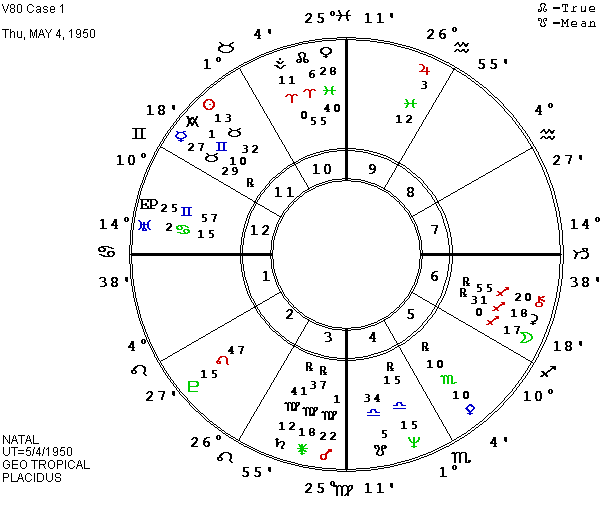
We are going to concentrate on the actual date of the child’s birth, looking at progressions and transits, including some of the less-used factors in astrology. Among the latter will be the nodes of the asteroids when relevant, and the quotidian angles. We interpret the nodes in the same way as the planets from which they are derived, but do not weight them as strongly. Quotidian angles are a progression of the MC, Ascendant, East Point, and Antivertex so that they circle the whole zodiac in a year unlike the usual progressed angles which move only about one degree in a year. Quotidian angles are the only true “day for a year” angles. Since the quotidian angles move 361 degrees in a year, they move approximately one degree a day. Only aspects within one degree to a degree and a half will be mentioned.
The first striking current pattern that we note is progressed Moon conjunct natal Ceres with the transiting Moon and the progressed north node of Ceres opposite. We thus have two forms of the Moon and two of Ceres in exact aspect. Simultaneously, we note that progressed Sun is conjunct the natal north node of Ceres. The progressed Ascendant is sextile-trine the progressed nodes of the Moon. The quotidian progressed Ascendant is trine progressed Venus. Progressed Mars is trine natal Mercury. Progressed Pluto has just reached the trine to natal Moon. Progressed Jupiter holds a long semi-sextile and quincunx to the natal nodes of the Moon. Pluto also continues its long sextile to natal Neptune. In this list, we have included all the rulers of the fourth and fifth houses and most of the keys to personal action. Of course there are some negative aspects; there always are. But the degree of harmony is remarkable. Even though the new mother will be giving up some of her independence and activity in the world, she is consciously and unconsciously ready to have a child and care for it.
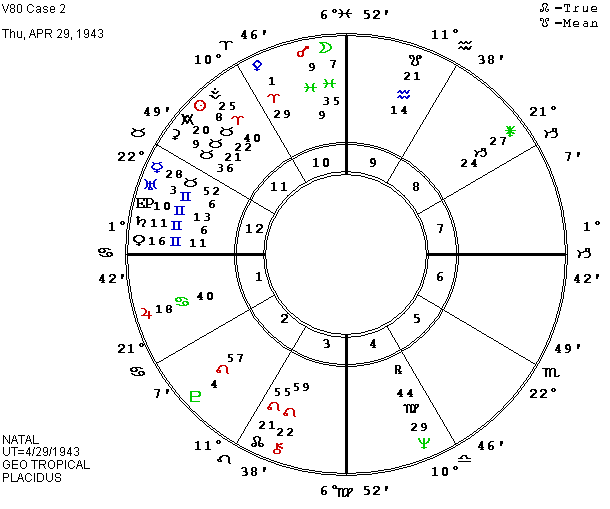
Case 2 became pregnant before marriage but married before the child was born. The pregnancy seemed normal and the delivery began normally, but complications forced a Caesarean section since the life of the child was endangered. After a few days, the child regained normal health. In studying the mother’s natal chart, we can see a similar identification with motherhood such as we found in the first case. Cancer is rising. Mars and Moon are conjunct in Pisces in the tenth house with Neptune in Virgo in the fourth house. The combination could indicate idealization of and identification with the mother role. We also have a Taurus Sun and it is conjunct Ceres quite closely in the eleventh house. Venus, ruling the fifth house, could mean that she will enjoy children, and its conjunction with Saturn again could indicate choosing the mother role while the twelfth house placement brings in the tendency to idealize once more. Mercury, ruling the fourth house, repeats the theme again with its twelfth house position, and so does Jupiter in Cancer, the fourth sign. In many ways, the two charts are similar and we have the same questions. Will Case 2 be satisfied being a mother, or will the earth part of the nature want to do more? Since the earth is largely in water houses, she may be able to accept a dependent role, supported by a “father-figure” husband with Capricorn on the seventh cusp and Venus conjunct Saturn. The earth forms a grand trine. Pluto, one of the fifth house rulers since Scorpio is in the house, is sextile Uranus and trine Pallas though it is also quincunx the MC. The chart is relatively harmonious, and if she has faith in a higher power she should be OK. The Pisces and twelfth house emphasis does demand such faith. With it, the individual is sheltered and protected. Without the faith, there is apt to be anxiety and problems. Again, we cannot know how the issue is being handled until we talk to the person or observe the life.
Turning to the current patterns at the time of the birth, we note (uneasily) that Vesta has been progressing over the Sun-Ceres conjunction and is still in orb to Ceres within the one degree permitted for progressions. Also, the progressed Ascendant has been square natal Vesta and on the day of delivery, the quotidian progressed Ascendant is just coming into the quincunx to natal Vesta but it trines progressed Venus conjunct Jupiter, a very protective combination. At the same time, progressed Venus-Jupiter is tri-octile natal Mars and the local MC. It is interesting that she has moved to a location which puts Mars right on the MC, highlighting some kind of confrontation between personal will and the limits of personal will, and possibly involving home and family in view of the closeness of the Moon and the aspects in Cancer. Mars, of course, represents our desire to be free to do what we please. Care of a baby is not likely to allow much of that freedom. When our self-will is too blocked, surgery is a common result. Another planetary combination involves progressed Sun conjunct the north node of Ceres (an identical aspect to Case 1) but in addition Sun is conjunct natal East Point and Saturn. The East Point is personal identity and action, like an auxiliary Ascendant. Saturn represents our role in society, our status and career, after we have learned the lessons of reality. Since Saturn rules the seventh house, this high focus on Saturn could point to her husband’s central role in the situation. Until we have learned the rules of the game, Saturn aspects can mean some form of anxiety, either from what the world might do to us, or from guilt. If she has developed faith, she can handle the situation.
There are also aspects involving the other rulers of the fourth and fifth houses, as we would expect. Progressed Moon (natural ruler of the fourth) is conjunct natal Mercury, ruler of Virgo on the fourth cusp, and it is trine natal Neptune in the fourth house. This suggests that she really wants the child even if there is some uneasiness about her independence, her relationship with the child’s father, or her ability to be a mother as a new role. With both Vesta and Saturn we may have similar questions. “Can I do a good job?” or “Should I be doing more than homemaking?” If the job is too much for our ability (realistically or due to perfectionistic expectations) or if the job is beneath our ability or aspirations, the outcome may actually be similar—we fumble in our handling of the job. If we are sure that is the job we really want and we can handle it, we do it easily and well.
As the outcome shows, the difficult but successful delivery and survival of the child, the inner harmony was enough to outweigh the ambivalence and anxiety. There are many other aspects which could be mentioned. Progressed Mars is trine natal Pluto; both ruling the Scorpio in the fifth house, and it is also sextile Uranus, perhaps reassuring her that she could maintain sufficient independence. Progressed Saturn is conjunct natal Venus, again connecting a fifth house ruler with the key to status and career, but suggesting some unconscious (twelfth house) anxiety if she is not sure of her ability to handle either the relationship with the mate or the motherhood. Could one threaten the other? Quite possibly. The relationship with her husband is in high focus. Juno, the asteroid of marriage, is conjunct the progressed Descendent, and the progressed Moon is trine Juno. We would need to explore her feelings about her marriage and how the baby might affect it if we were interpreting her chart in a counseling session.
The picture is further complicated by the fact that the progressed Moon is conjunct the midpoint of natal Vesta-Ascendant. The emphasis on Vesta and Saturn certainly put her feelings about her role in high focus, and we again wonder whether she is feeling pulled between being wife and mother. The real danger of Vesta is our tendency to have to do one thing so well that we neglect another area of life. Or the mixture of parent-child-partner combinations can mean that we have chosen a partner to be parent or vice versa. Unless we can take turns with the role, the one playing child may end up resentful of the ego-putdown or the one playing parent may resent the burden. There are many other aspects which could be mentioned, including some involving intermediate house cusps and midpoints. One such cluster includes the progressed quotidian fifth house cusp conjunct Mars/Ceres, Moon/Ceres, Sun/Mars, and MC/Ceres and the natal eleventh house cusp. The combination echoes our theme of motherhood potential (Sun-Moon-Ceres) with personal action and identity but possible ambivalence over the restrictions involved (Mars) with status-role (MC) and the houses of children (five-eleven). No matter what factors we use in our current patterns, the same message comes through.
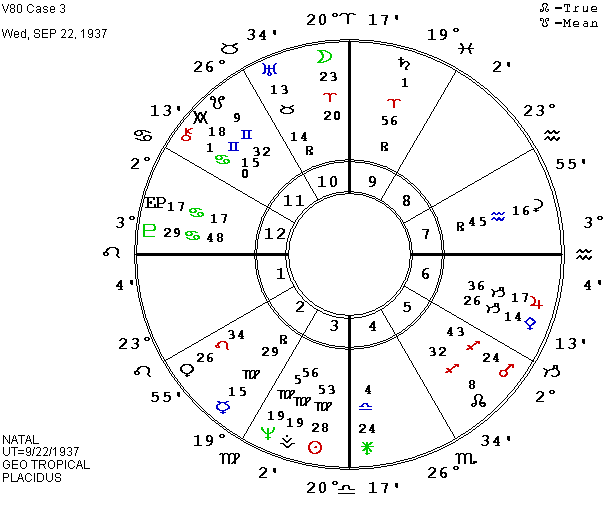
Case 3 consciously wanted a baby, but her health was not good. She had raised four children and was in a new relationship with a man who also very much desired a child. Fairly early in the pregnancy, the baby miscarried and Case 3 had to have a D & C. Leo rising and Mars in the fifth house in the natal chart may be identified with procreation, or may prefer other forms of creativity and emotional response from the world. Again, idealism is involved: Mars and the north node are in Sagittarius in the fifth house, while Pluto, ruling the cusp of the fifth is in the twelfth house conjunct the Ascendant. Venus and Mercury, rulers of the eleventh house, are both in the second house for potential pleasure from children. Venus is mostly well aspected, trine natal Moon in Aries in the tenth house (repeating the possible identification with motherhood as a major role), semi-sextile
Pluto (ruler of the fifth) and semi-sextile Sun (natural ruler of the fifth). There is more emphasis on the procreation end than on the nurturance side of motherhood, but Pluto, East Point, and Chiron are in Cancer, and Juno in the fourth house suggests the choice of a nurturing mate, as does Ceres in the seventh house. Venus is also trine Mars in the fifth, so the grand trine in fire is all connected to 4, 5 and 11. Mercury is conjunct Neptune to add to the idealism, and Vesta to add to the capacity to be conscientious and responsible. Mercury is also part of a grand trine, to Jupiter and Uranus in earth signs and houses. The general harmony in the chart looks good for children, and she has raised four successfully. One is forced to wonder about all that earth and fire continuing to be restricted to home-making and motherhood, but current patterns may clarify the situation.
Some of the progressed aspects fit the conscious desire for another child. Progressed Venus was semi-sextile natal Mercury while progressed East Point was conjunct natal Venus. Progressed Sun was semi-sextile the north node in the fifth house but quincunx the south node in the eleventh house. Progressed Moon was conjunct natal Juno in the fourth house and sextile natal Mars in the fifth house, having just finished the opposition to natal Moon in the tenth house. Progressed south node of Ceres was conjunct the north node of the Moon in the fifth house, while progressed south Vesta was conjunct Mars. Progressed MC was sextile Pluto on one side and the midpoint of progressed and natal Saturn on the other side. But some other aspects offered clues to ambivalence about the situation. Saturn remained in a long opposition to the natal Sun, though it also trined Pluto. Ceres was trine the Antivertex but quincunx East Point and moving into the quincunx to Neptune. But the major clue was Mars. Progressed Mars had started the square to natal Moon; a quincunx to the local Ascendant; an octile-tri-octile to the nodes of the Moon. At the same time, we have mentioned that the progressed Moon and south Vesta were aspecting natal Mars, and on the day of the miscarriage, the quotidian Ascendant was square natal Mars; transiting Mars was conjunct the natal Ascendant; transiting Vesta was quincunx natal Ascendant and octile progressed Ceres; the local progressed MC was just about to leave the opposition to natal Mars; local progressed East Point was square natal Mars. Echoing the “freedom” emphasis, progressed Mercury was opposite progressed Uranus, and transiting Ceres was conjunct Jupiter, square progressed Venus. Case 3 consciously wanted this child, but her need for freedom (emphasized by the high focus on Mars) and to accomplish something more in the world (suggested by the general emphasis on earth including Vesta) were apparently pushed into the unconscious and the unconscious usually wins.
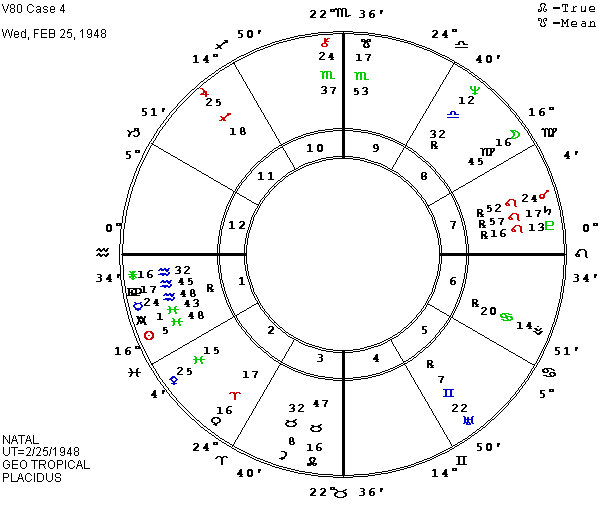
Case 4 had a normal pregnancy but the baby died during her labor, prior to delivery. An autopsy could find no reason for the death. Afterwards, she recognized that she had been blocking feelings of ambivalence about having the baby since her relationship with the child’s father was shaky and she was not really sure she wanted a child by that man. We can see strong freedom emphasis in the natal chart. Uranus (conjunct the north node of Vesta) is in the fifth house opposite Jupiter in Sagittarius in the eleventh house—a very strong statement of independence which is backed up by the first house loaded with Aquarius. Venus in Aries adds its quota to the theme. On the opposite side, we have a strong emphasis on the seventh and eighth houses, with Saturn looking for a father; Moon seeking a mother; Neptune searching for God; and Mars ambivalent about her own power, projecting it and taking it back. Planets in the fixed signs, including Chiron, MC, nodes, Juno, East Point, Mercury, Pluto, Saturn, Mars, form a grand cross, strongly suggesting power struggles. Her local MC for the event was exactly opposite the north node of Ceres, and her local Ascendant was exactly square natal Ceres. The midpoint of the two MCs was exactly square the Mercury-Mars opposition and closely conjunct Chiron. The issues of power, pleasure, possessions, in the relationship with the baby’s father were tense, and it seemed likely that he might abandon her and the child. He was consciously reluctant to undertake the responsibilities of being a father. Apparently, instead of finding a “father-mother-god”, she was playing those roles to him, having picked out a weak person to assure herself that she would not give the power away. Relating to a weak person leaves us with the power and no threat to our independence, but it does not produce a comfortable relationship.
The progressions show the tension clearly. Progressed Venus and Ceres were conjunct the north node of the Moon, supporting the urge to have a child, but they were also square progressed Mars and the East Point-Saturn opposition, with the progressed Sun octile-tri-octile the combination. Progressed Vesta had turned direct and reached the square to natal Venus and the tri-octile to natal Antivertex. The progressed south node of Ceres had reached the square to Neptune in the eighth house and progressed north Ceres was square the Antivertex. Progressed north Vesta remained conjunct Uranus in the fifth house. Progressed Moon was opposite progressed Ascendant with both of them square the quotidian eighth cusp and transiting Neptune. The quotidian Ascendant was quincunx Neptune and square Pluto. The local progressed MC was conjunct Jupiter and square Pallas, while progressed Jupiter was tri-octile Pluto. Progressed Juno was square the local MC-IC. The general picture confirms the uncertainty over the relationship, over what was really desired and over the ability to handle the situation. In the face of the tension and uncertainty, it would seem that the baby decided to wait for a more auspicious opportunity.
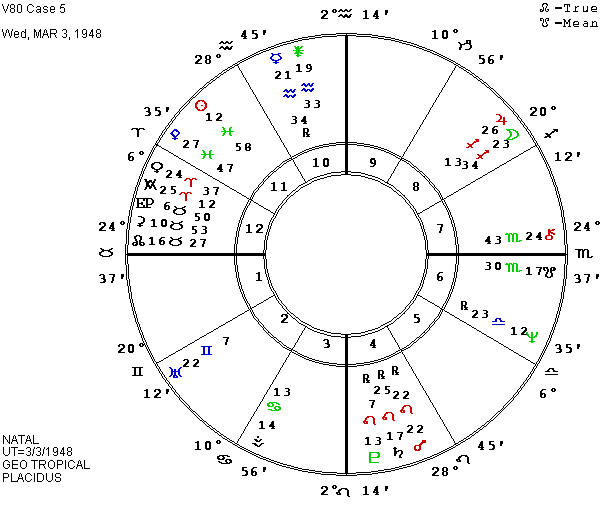
Case 5 chose to have an abortion. Consciously, she was very sure that she did not want children. She was fairly happily married, but very independent and living a rather unconventional and rootless life. Her desire for freedom and variety (she travels frequently and lives in other countries) shows in her Moon conjunct Jupiter in Sagittarius in opposition to Uranus. She also has strong Aquarius, including Sun in the eleventh house, and Venus in Aries.
(Note that she was born just a few days later than Case 4.) She has enough action in the seventh and eighth houses to feel the need for a peer relationship, in addition to Juno conjunct Mercury, one of the first house rulers (Gemini in the first house). But with the Mars in the fourth house and Chiron exactly opposite the Ascendant, she is always coming and going and consciously does not wish to be tied down with a family.
The other side of the coin shows in the unconscious where her twelfth house Ceres is at the midpoint of Antivertex and Ascendant and is conjunct East Point and north node of the Moon. The loaded fourth house and Moon in the eighth house also contribute to the unconscious attraction toward home and family.
When the conscious mind and the unconscious are in conflict, the unconscious usually wins. When her progressed Sun reached Sun/Ceres but was opposite Neptune, she conceived a child and had the abortion. Other aspects which supported the picture were progressed Moon opposite natal and transiting Vesta; quotidian Ascendant conjunct progressed Vesta; progressed Sun square progressed south Ceres; progressed Venus octile progressed Sun; progressed Ceres square natal Mercury; progressed Ascendant opposite Jupiter in the eighth house; progressed north Vesta still conjunct Uranus which had just progressed to oppose natal Moon; etc. Within the following two years, her progressed Venus reached the north node of Ceres, she conceived again and had another abortion. She is still totally unconscious of any desire for a child, and as long as the desire remains repressed, her unconscious will continue to try to give her what she does not know she wants.
The moral of the story is not that we can guess what will happen out of any collection of aspects. There are always both harmonious and stress aspects in every chart. What the chart can do is help us to recognize the parts of ourselves which are less conscious so that we can try to integrate the conscious and unconscious aspects of ourselves. We can usually get what we want if we are clear and not ambivalent about it, provided it is within our power and not a denial of the rights of someone else. One stops believing in accidents or chance after working with astrology. Character produces destiny and the horoscope helps us to see both the inner and the outer urges of the character. Insight can facilitate our efforts to integrate in order to move toward an effective and fulfilling life.